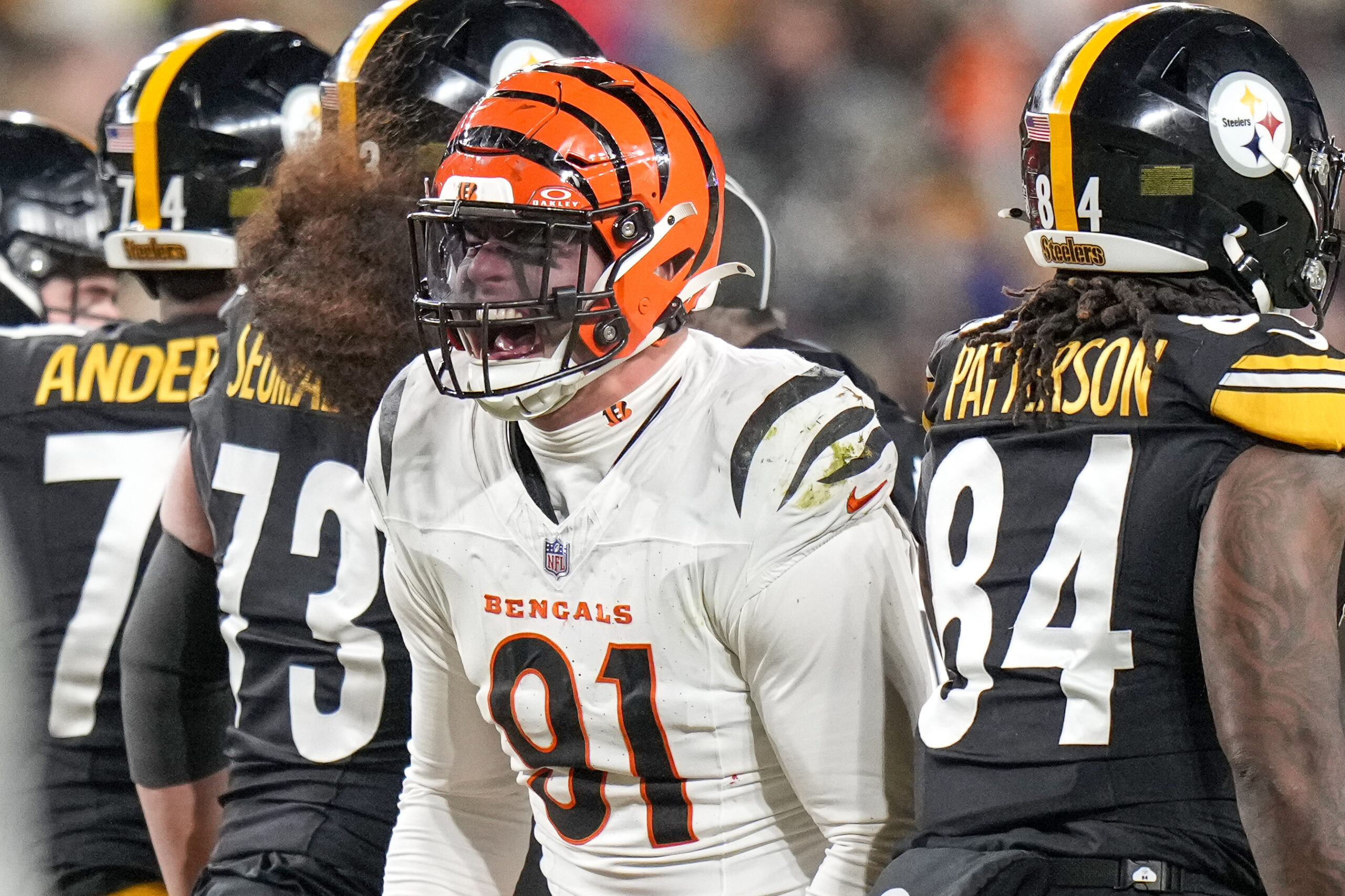NFL Analysis
12/16/24
22 min read
1st & 10 Week 15: Josh Allen Does it Again, Eagles Passing, Mahomes Still taking Hits
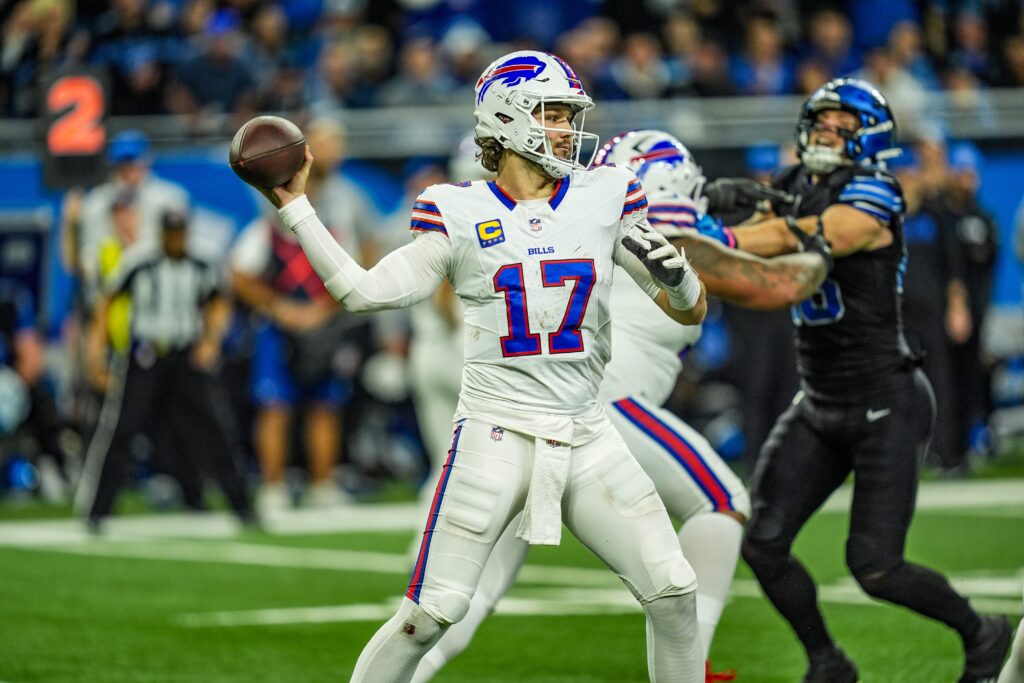
In the first full week with no byes remaining, we had a packed but underwhelming early slate of games, while the later games had some juice, including a potential Super Bowl preview.
Each week, 1st & 10 will bring you a Monday morning an in-depth breakdown of everything you need to know from Sunday’s slate of games. We’ll fill this column with stats, film, and plenty of words to keep you covered on anything you might have missed or want to dive deeper into from Sunday.
All stats provided by TruMedia unless noted otherwise
1st & 10 NFL Week 15
1. Bills outscore, outmatch the Lions
The matchup between the Buffalo Bills and Detroit Lions was anticipated as a potential Super Bowl preview. Detroit has been the best team in the league for much of the season — first in DVOA — and the Bills have the best offense, led by the current MVP favorite.
This game was also expected to give us a fun clash of styles, especially when the Bills had the ball. Detroit’s defense has been one of the best in the league by relying on aggressive man coverage. The Bills knew this and immediately went to work on isolating one of the weaker units on the defense in Detroit’s linebackers.
On a second-and-5 on Buffalo’s opening drive, the Bills sent Khalilk Shakir in orbit motion. Against man, that pulled a defender from the left side of the field. Then, at the snap, Ty Johnson came released vertically out of the backfield and was able to run past linebacker Kwon Alexander (10) for a 33-yard gain.
— Dan's Clips (@dansfilmclips) December 16, 2024
Later in that drive, Allen found Johnson again, but this time, it was with Allen making one of his unbelievable plays where he extended to the sideline and somehow found an impossible throwing angle back to the middle of the field.
Early in the second quarter, the Bills faced a fourth-and-2 from midfield. Johnson started in the backfield but motioned out into the slot to create a trips alignment to the right side of the formation.
When Johnson motioned, LB Ezekiel Turner went with him, giving a man coverage indicator. The Bills ran a pick with Dalton Kincaid, who lined up as the No. 2 in the middle, as Johnson ran a wheel from the inside for a gain of 31.
— Dan's Clips (@dansfilmclips) December 16, 2024
Alexander and Turner were playing because of the injuries to Detroit’s linebackers. The Lions' defense has been decimated by injuries in the past few weeks, and things did not get better. After the game, Dan Campbell announced it looks like Alim McNeill and Carlton Davis will be out for the rest of the season.
Buffalo had a mixture of working the weak points of the Detroit defense but also having Allen do Allen things.
On his second touchdown run, the Bills got both at the same time. Buffalo pulled a tackle on the goal line to set up an Allen run, but a linebacker followed Johnson to the left, and two Detroit defenders went with Reggie Gilliam, lined up as a fullback, which created a wide-open lane for Allen. It’s not often there’s an assignment miscommunication on the Lions’ defense, but it gave Allen one of his easiest scores here.
The Lions couldn’t quite figure out the best way to defend Allen, and it might not have mattered since he was ready for anything. The Lions have gotten pressure this season by being an aggressive, blitzing team. They did that but completely changed from their normal game plan.
Through Week 14, only the Buccaneers blitzed on third down more than the Lions (38.9 percent). But against the Bills, the Lions blitzed on 42.9 percent of Allen’s early down dropbacks and did not send a third down blitz the entire game. It was only the third time in Aaron Glenn’s tenure as defensive coordinator that the Lions did not send a blitz on third down. The other two games were divisional wins.
Allen was still pressured on 42.9 percent of his third-down dropbacks, but without the extra rushers, he was able to extend plays and did not take a sack.

Allen was in creation mode all game, regardless of the down.
Allen finished the game with 0.57 EPA per play and a 60 percent success rate. He still leads the league in EPA per play.
The Bills have the best offense in the league by EPA per play and EPA per drive. At 1.00 EPA per drive, Buffalo has the 10th-best offense by that metric through Week 15 over the past 15 seasons.
Highest EPA per drive through Week 15 since 2010 (per TruMedia)
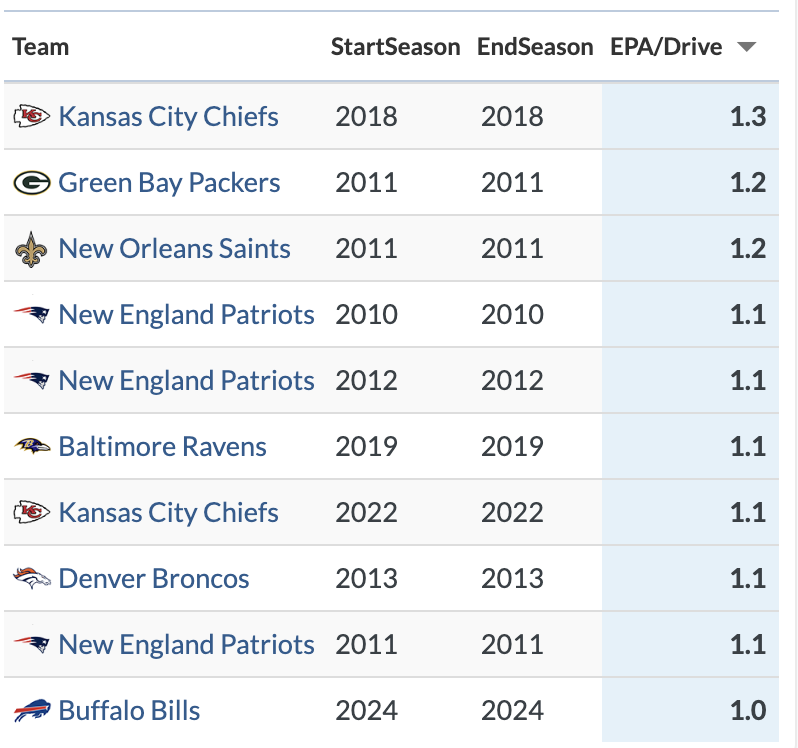
Defensively, the Bills forced the Lions into relying on Jared Goff dropbacks. Buffalo played with the lead but also held Detroit’s rushing offense in check. The Lions only had a 30.8 percent rushing success rate, their second-lowest of the season.
Goff had success finding holes in a Buffalo defense that was also missing key starters in the secondary and threw five touchdown passes with no interceptions.
His 66-yard touchdown pass to Amon-Ra St. Brown was a beautifully placed ball on a dig over both Buffalo linebackers, who knew the exact throw that was coming but still couldn’t get to a place to stop it.
But it was never enough to fully get the Lions back in the game. He still finished with 0.35 EPA per play and a 51.6 percent success rate.
Buffalo is still two games behind Kansas City for the top seed in the AFC, but the Bills might be playing their best football now. They’ve scored 30 or more points in eight straight games.
The Lions are tied with the Eagles for the best overall record in the NFC, but Detroit holds the tiebreaker with a superior conference record (8-1 to 7-2). The Lions finish the season with the Bears, 49ers, and Vikings, while the Eagles finish with the Commanders, Cowboys, and Giants.
The Upshot gives the Bills a 12 percent chance at the bye in the AFC, and the Lions still have a 60 percent chance of getting the bye in the NFC.
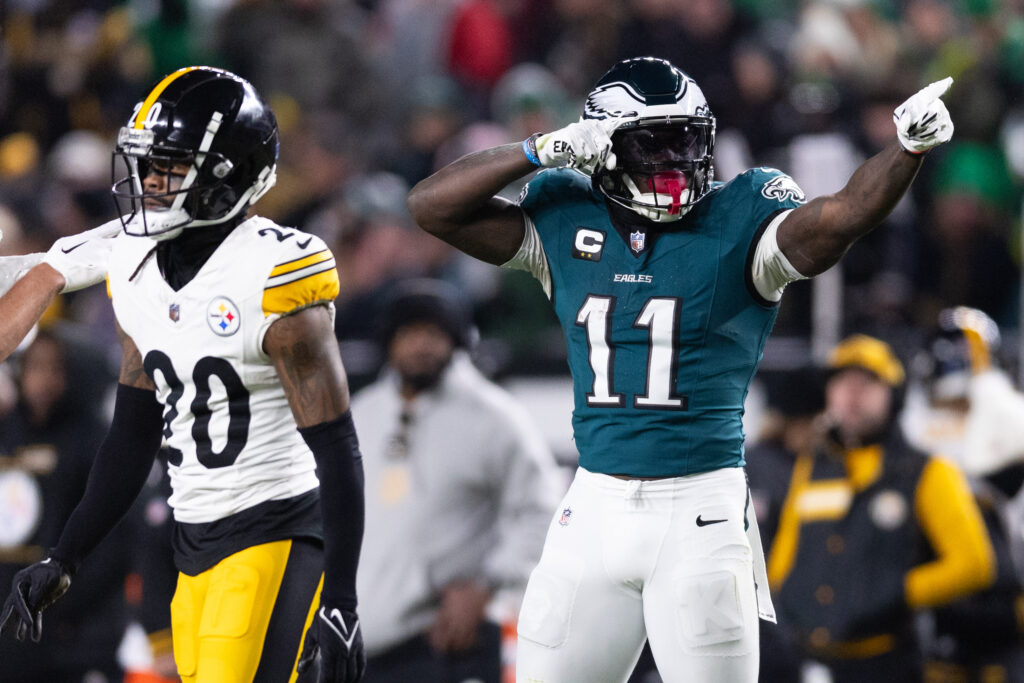
2. Eagles Improved Their Passing
Last week, when asked what the Philadelphia Eagles needed to improve, A.J. Brown simply said, “passing.” Technically, it wasn’t the wrong answer.
Their defense has been among the league's best since the midway point of the season, and the running game has been explosive, with Saquon Barkley as a potential MVP candidate. But after a Brandon Graham interview suggested some troubles between Brown and Jalen Hurts, that comment seemed to take on a life of its own.
Well, the Eagles fixed their passing in a 27-13 win against the Pittsburgh Steelers. Hurts had 290 passing yards, his highest total since Week 3, with two touchdowns.
The passing game led the way as Barkley only had 65 yards on 19 carries, even as the Steelers played often with lighter boxes early in the game.
In the first half, Pittsburgh tried to mess with Hurts’s timing by bringing a blitz on 44.4 percent of his dropbacks. That’s been an effective way to get to Hurts during his career, but he was calm and prepared for it in this game. Against the blitz, Hurts went 8-of-11 for 92 yards and both of his passing touchdowns. He averaged 0.66 EPA per play with a 72.7 percent success rate against the blitz.
When Pittsburgh brought those extra rushers, it often tried to play man coverage behind it, and that didn’t work. When the Steelers played man, Hurts went 11-of-13 for 138 yards, according to Next Gen Stats.
That’s where Brown was at his best. Brown was targeted on eight of his 13 routes against man, recording six receptions for 89 yards and a touchdown.
When the Eagles have gotten into trouble, it’s partly because Hurts has held onto the ball and turned down throws that could have been open. That’s led to some of those extended plays disrupting the timing of the offense. In the first half, Hurts averaged 2.74 seconds to throw and looked more comfortable in the rhythm of the offense.
On throws with 2.5 seconds of the snap, Hurts went 14-of-17 for 157 yards and 0.87 EPA per play with a 75 percent success rate. It was his most such attempts since Week 6.
The passing game was funneled through the two top receivers. DeVonta Smith had a 38.7 percent target share, while Brown was at 35.5 percent. Kenneth Gainwell was third on the team with three targets.
The Eagles dominated the time of possession in the second half, and they did a lot of that by passing the ball, with the running game not being as effective. Barkley only had a 31.6 percent success rate, while 36.8 percent of his runs were stopped at or behind the line of scrimmage; his lowest success rate and highest stuff rate in a game this season. He only averaged 0.37 yards before contact per rush.
In the second half, 58.3 percent of Barkley’s runs came against a stacked box, and he only had a long run of nine yards.
The Steelers backed off of blitzing in the second half (15 percent) but pressured Hurts more as he went back into creation mode and held the ball longer (3.63 seconds).
Yet, Philadelphia had two 13-play drives to start the second half. The Eagles had a 7:08 field goal drive that lasted 13 plays and 47 yards to open the half. On the next drive, the Steelers fumbled on a pitch from Russell Wilson to Najee Harris after four plays, and the Eagles recovered. Philadelphia then went on a 6:33 touchdown drive that went for 13 plays and 74 yards, resulting in a 27-13 lead.
Pittsburgh got the ball back and went seven plays and 24 yards. It faced a fourth-and-7 at the Philadelphia 46-yard line with 10:40 left in the fourth quarter. Per the ESPN fourth down model, going for it would have been the ideal outcome, but it was close, as it was just a 0.3 percent win probability swing. Instead, Mike Tomlin sent out the punt unit, and the Steelers didn’t touch the ball again.
The Eagles ended the game on a 21-play, 88-yard drive that lasted the final 10:29 of game time. It was the ninth-longest fourth-quarter drive in the past 20 years and the third-longest to end a game.
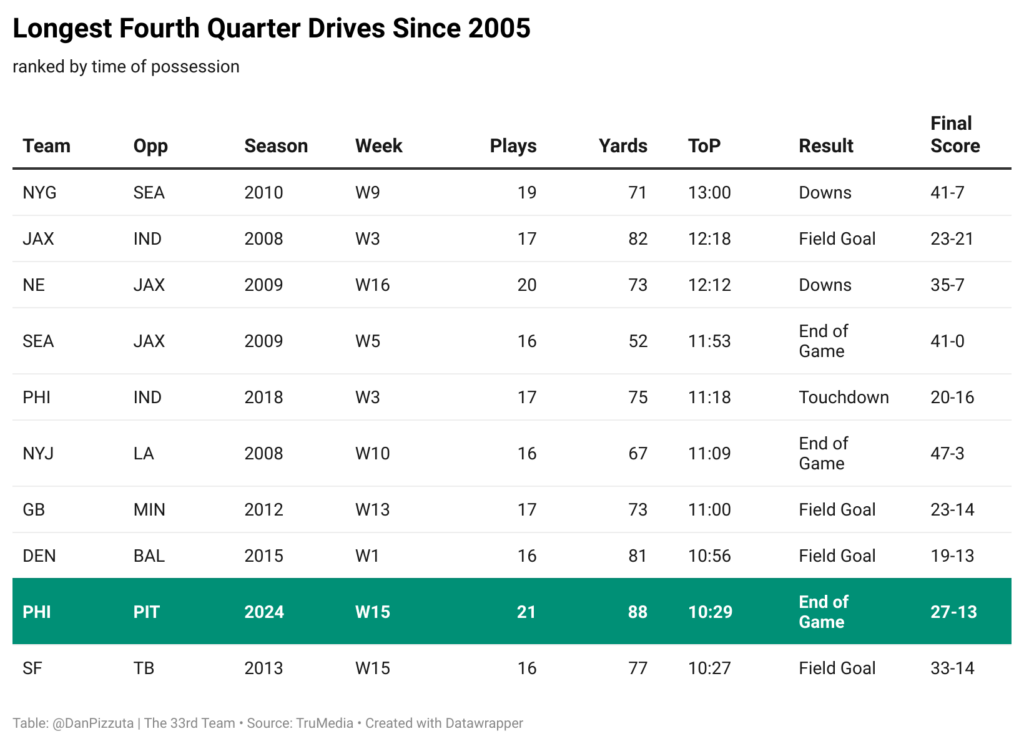
It’s the longest fourth-quarter drive-by-plays since at least 2000.
While the Eagles ran on two-thirds of the plays on that drive, they only had a 34.1 percent rushing success rate on the final drive, while they had a 57.1 percent passing success rate.
When Jalen Hurts went up to the podium for his post-game press conference, he started with, “So that’s what you wanted to see, huh?”

3. The Colts fumbled away a playoff chance
With 12:43 remaining in the third quarter, Jonathan Taylor broke free down the right sideline and scored a 41-yard touchdown that put the Indianapolis Colts ahead of the Denver Broncos 20-7—or so they thought.
Upon review of the play, it was determined Taylor had dropped the ball before crossing the goal line, so the play was ruled a fumble out of the end zone for a touchback.
It was a massive swing in the game that was the most important for playoff odds in the AFC. According to The Upshot, with a win, the Colts would have had a 77 percent chance to make the playoffs. With a loss, it would have dropped to 16 percent.
A 20-7 lead would have been comfortable against a Denver offense that was struggling up until that point in the game. Instead, after the turnover, the Colts did not score again. The Broncos won 31-13, and now Denver has a 90 percent chance to make the playoffs.
Yet, even after Taylor’s fumble, the Colts had chances to pull away. Taylor's run was set up by a Bo Nix interception. After trading punts, the Colts picked Nix off again — his third of the day.
Nix struggled throughout the day when hanging in the pocket. The Broncos did a good job of helping him out with screens and swing passes that created positive plays, but Nix had a massive split between getting the ball out quickly and holding onto it for more than 2.5 seconds.

The Colts' defense had played well, but on the first play of the next drive after Nix's third interception, Michael Pittman fumbled.
Denver went on to kick a field goal and then a touchdown after a Colts punt.
With the score 17-13, Indianapolis head coach Shane Steichen called for a trick play in an attempt to spark the offense. Richardson threw a backward pass to Adonai Mitchell, and Mitchell was supposed to throw the ball back to Richardson.
But in the time it took Mitchell to set his feet and flip the ball to the laces, Nik Bonitto charged through the line, caught the ball for what was considered a fumble, and ran it back for a touchdown.
Richardson had been playing fine in the first half, getting back to having success on the ground, but as the Colts needed to throw to get back in a game that was slipping away, things kept getting worse.
He finished 17-of-31 for 4.5 yards per attempt and two interceptions. He averaged -0.70 EPA per play with a 34 percent success rate as he was pressured on 46.5 percent of his dropbacks.
That put the Denver defense in an advantageous situation and allowed Pat Surtain to do things like this:
The Broncos' defense is first in EPA per play on the season and first in EPA per dropback by a wide margin, more than double the next-highest team (0.11 to 0.05).
It’s a unit that can cause havoc in multiple ways — nine different Broncos had a pressure in the game, with Zach Allen and John Franklin-Myers leading the way with five each. It’s a unit that can change any game, lift an offense if it struggles, and be dangerous in a playoff game.
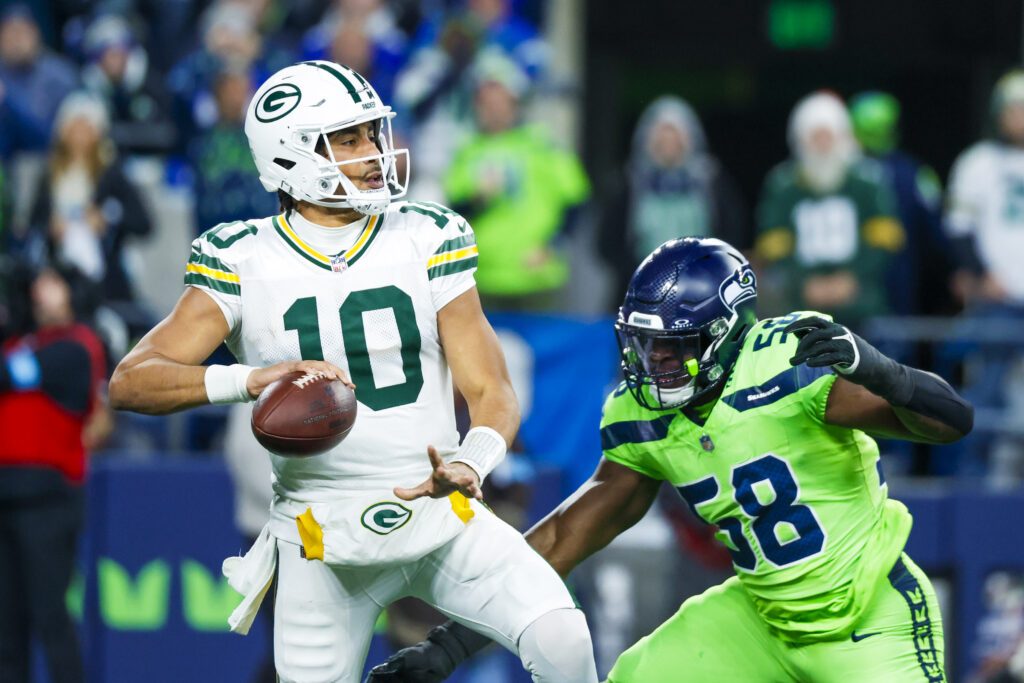
4. Packers And Seahawks are going in opposite directions
The Green Bay Packers have a 10-4 record after a 30-13 win against the Seattle Seahawks on Sunday Night Football. They have no shot at winning their own division, yet they have the upside to be the NFC representative for the Super Bowl. Their ceiling is that high.
It’s not crazy to think. Green Bay came into this game ranked third in overall DVOA behind Detroit and Baltimore. The Packers were about even with the Bills on offense and defense, but Buffalo’s 29th-ranked special teams bumped them down.
This is a team that is getting good play from everywhere and can win in a multitude of ways. During the past few weeks, the Packers haven’t needed to rely on high-volume output from Jordan Love while the running game has taken control. But against Seattle, the run game had a 35.3 percent success rate, so the Packers needed a little more through the air.
Love averaged 8.5 yards per attempt and 0.16 EPA per play, with a 60.7 percent success rate. Love is truly one of those quarterbacks who can make every throw, and he’s willing to do so.
Give him a 1-on-1 matchup, and he’s going for it.
Show a Cover-0 look, and he’s going to go after that, too.
Love appears to play recklessly, but it’s often more controlled than it looks.
Late in the second quarter, the Seahawks jumped offsides, so Love knew it was a free play. He drifted back, faded away, and threw a jump ball in the middle of the field, which was caught by Tucker Kraft.
Now combine that with a defense that forced two turnovers and had seven sacks split between Geno Smith and Sam Howell. Green Bay had a 45.2 percent pressure rate, which was the third-highest of the week. The Packers took advantage of a Seahawks offensive line that has been inconsistent throughout the season. They’re now sixth in EPA per play on defense for the season.
Green Bay should have a bright future, but Seattle’s is murkier after this game. Smith left early with a knee injury, and while it appears to be okay structurally, his status is up in the air. Seattle’s loss dropped them to 8-6, and according to The Upshot, they now have a 34 percent chance to make the playoffs. A win would have put the Seahawks at 65 percent.
The Seahawks and Rams are tied at 8-6, while the Cardinals are just behind at 7-7. Seattle has to play Minnesota next week and might be sending Sam Howell out against the Brian Flores defense.

5. Buccaneers Offense Bests Chargers Defense
The Tampa Bay Buccaneers' offense continues to do some really fun things — proven by the ability to put up 40 points on a good Chargers defense.
It started early in the game. The Buccaneers had a third-and-3 from the Chargers’ 26-yard line. Tampa Bay came out in trips with Jalen McMillan as the inside No. 3 receiver.
At the snap, McMillian ran his route underneath the other two receivers, Mike Evans and Cade Otton, to set a legal pick, and that sprung McMillan free for a wide-open touchdown.
— Dan's Clips (@dansfilmclips) December 16, 2024
Baker Mayfield had a 9.7-yard aDOT and still completed 87.5 percent of his passes. He did not throw into a tight window on any of his passes beyond 10 yards past the line of scrimmage, per Next Gen Stats. Mayfield averaged 0.47 EPA per play with a 60 percent success rate.
He found Mike Evans for a 57-yard touchdown on an extended play early in the third quarter.
When he has plays like that, his confidence builds, and he’s more willing to rip some throws, like the 35-yard touchdown to Evans later in the third quarter.
Evans accounted for 42.3 percent of the Tampa Bay targets against the Chargers. He now has 749 receiving yards on the season and needs 251 during the next three weeks to top 1,000 for the 11th-straight season.
This has been a remarkable offensive season for the Buccaneers, especially considering the injuries suffered at receiver. Last week, Tampa Bay used 13 personnel for 10.2 percent of their plays and averaged 0.31 EPA per play. It was the first time the Buccaneers had put three tight ends on the field for more than 5.2 percent of their snaps in 2024.
Against the Chargers, the Bucs used 13 personnel on 22.5 percent of their plays. This was mostly to run, and they had a 50 percent rushing success rate, including a 54-yard Bucky Irving run in the third quarter that pulled a guard and the H-back to open the running lane.
It will be fascinating to see if the Buccaneers will continue to pursue that strategy and if it can be a way to overpower opponents on the ground.

6. Houston Clinches Division Thanks To Defense
The Houston Texans defense came through in a 20-12 win against the Miami Dolphins. The Texans forced Tua Tagovailoa into three interceptions and a lost fumble while the Houston offense again struggled to find much consistency.
Houston allowed just 3.6 yards per play, and the big plays were fantastic. Derek Stingley Jr. continued to put a stamp on his All-Pro-caliber season with two interceptions — both sensational plays.
On the first interception, Stingley lined up across from Tyreek Hill in the slot. Tagovailoa thought Hill was going to have leverage breaking out against Stingley, but the separation was never created, and Stingley stepped in front of Hill for the pick.
— Dan's Clips (@dansfilmclips) December 16, 2024
Stingley just ripped the ball out of Hill’s hands on a jump ball for the second interception, which clinched the game with just more than a minute and a half remaining.
It was a great showing for a defense that has been stout against the pass and has allowed the fourth-lowest rate of explosive passes this season (11.9 percent).
Outside of two C.J. Stroud to Nico Collins touchdowns, the offense struggled. Even with the touchdowns, the Texans averaged -0.28 EPA per play overall and had a 14.3 percent rushing success rate. Houston only averaged 3.6 yards per play.
With the win and the Colts’ loss, the Texans clinched the AFC South. That was expected before the season, but this team still looks nothing like what many expected it would be after how last season ended.
A bye week didn’t help the offense at all, and in some ways, it looked worse. Given that, it’s hard to believe there will be many changes down the stretch and into the playoffs, which doesn’t say much about Houston’s hopes of being a contender in the AFC.

7. Washington Barely Survives Late Saints Comeback
There was some good and bad in Washington’s 20-19 win over New Orleans. Early in the game, it again looked like the Commanders were onto something on offense, moving players around to get more variation with No. 2 receiver Noah Brown out.
Terry McLaurin lined up to the right on a season-high 27.3 percent of plays. He had two touchdowns and was near an even bigger day than the seven catches and 73 yards he had.
Jayden Daniels continues to look more comfortable with his legs, but missing center Tyler Biadasz was a big deal. Daniels took eight sacks — a 20.5 percent sack rate. Seven of those sacks came without a blitz.
Washington never fully pulled away in this game, and it almost cost them at the end.
In the first half, the Commanders handled Jake Haener, who averaged -0.83 EPA per play with a 14.3 percent success rate. But once Haener was replaced with Spencer Rattler, the New Orleans offense took off. Rattler completed 10-of-21 passes but had 135 yards and averaged 0.61 EPA per play while making some big throws.
Washington pressured Haener on 64.3 percent of his dropbacks but only pressured Rattler on 25 percent of his.
Rattler led a drive that resulted in a touchdown, and the Saints were down by one with no time left on the clock. The Saints elected to go for two and failed.
8. Chart of the day
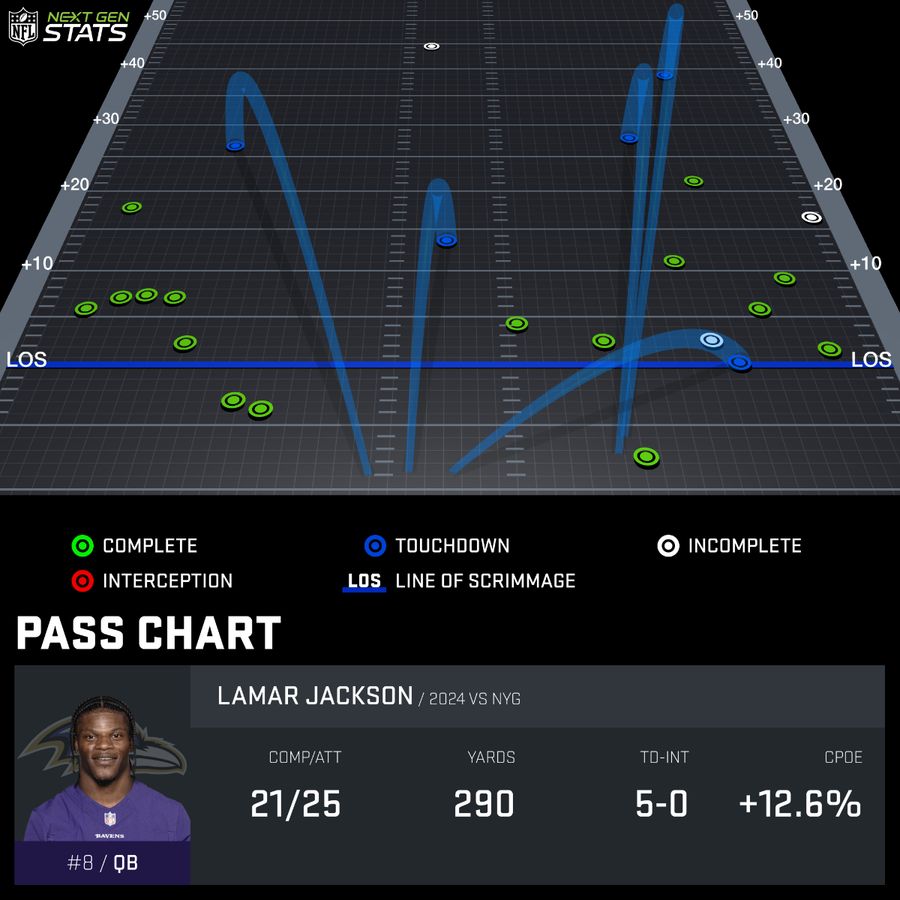
Lamar Jackson had a day.
Jackson with 0.64 EPA per play and a 66.4 percent success rate in a 35-14 win against the New York Giants. He had more touchdown passes (five) than incompletions (four). Per Doug Clawson of CBS Sports, it was Jackson’s fifth career game with at least five touchdown passes and five or fewer incompletions. No other quarterback has more than three.
9. Play(s) of the day
With a shoutout to Dan Skipper, who caught a touchdown, and Jonah Williams, who saved a fumble for the Cardinals in the end zone, it was a banner day for big-man plays. We’ll focus on the Titans-Bengals game, which had two of them.
First, T’Vondre Sweat picked up a fumble and started moving. That included a nasty stiff arm to Alex Cappa.
Then, later in that quarter, defensive end Sam Hubbard reported as an eligible receiver and did his best Mike Vrabel impression with a touchdown catch coming off the end of the line.
Hubbard previously had one target in 2008 as a fullback on a third-and-1 at the goal line, but Jeff Driskel threw the ball wide.

10. Can The Chiefs Protect Patrick Mahomes?
Patrick Mahomes injured his ankle in a 21-7 win against the Cleveland Browns, and he left with eight minutes remaining in the game. His status for Saturday’s game against Houston is unknown.
Pass protection has been an issue for the Chiefs all season, especially at tackle. Against the Browns, Mahomes was pressured on 33.3 percent of his dropbacks, but he did not take a sack.
Mahomes took 11 hits in the game, the third game in a row with 10 or more hits. It’s the seventh game in a row in which Mahomes took seven or more hits. That is tied for the longest streak for a quarterback since 2000.
Longest Streaks for 7+ QB Hits in a Game Since 2000 (Per TruMedia)

Since Week 9, Mahomes has led the league in quarterback hits taken. That’s not a sustainable way to keep a quarterback on the field, and those hits might have caught up to the Chiefs.
Mahomes has played extremely well while limited by a foot injury before, but the Chiefs shouldn’t be hoping for that going forward.


